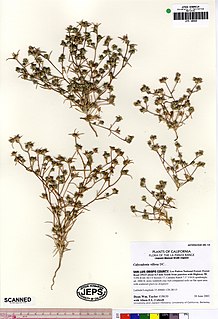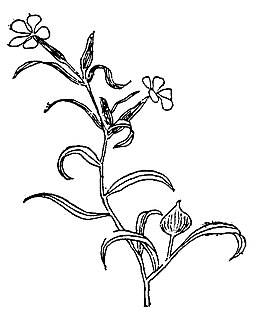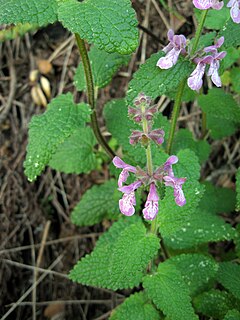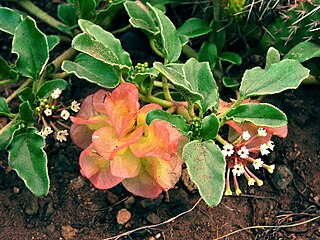
Spergularia is a genus in the family Caryophyllaceae, containing salt-tolerant plants known as sandspurrys and sea-spurreys. There are about 60 species.

Vicia hirsuta or Ervilia hirsuta is a species of flowering plant from the large genus Vicia.

Spergularia rubra, the red sandspurry or red sand-spurrey, is a plant species in the family Caryophyllaceae. It is native to Europe, Asia and North Africa, and it is present on other continents, including North and South America and Australia, as an introduced species and in many areas a common weed. It grows in a wide variety of habitat types.

Calycadenia villosa is an uncommon species of flowering plant in the family Asteraceae known by the common name dwarf western rosinweed. It is endemic to central California, where it is known from a limited distribution in the Central Coast Ranges in Monterey County and San Luis Obispo County, with a few populations in Santa Barbara and western Fresno Counties. There are perhaps 16 occurrences.
Potentilla biennis is a species of cinquefoil known by the common names biennial cinquefoil and Greene's cinquefoil. It is native to western North America from northwestern Canada to the southwestern United States, where it grows in moist habitat. This is an annual or biennial herb producing an erect stem up to 70 centimeters tall from a taproot. It is hairy and glandular in texture. The hairy leaves are each divided into three toothed, oval leaflets each up to 3 centimeters long. The inflorescence is a cyme of several flowers. Each flower has five oval yellow petals 1 or 2 millimeters long and five triangular sepals which are slightly longer. The fruit is a minute whitish achene.

Sagina apetala is a species of flowering plant in the family Caryophyllaceae known by the common names annual pearlwort and dwarf pearlwort. It is native to Europe and it is known elsewhere as an introduced species, including parts of North America. It grows in many types of disturbed habitat, such as cracks in the sidewalk. It is a petite annual herb producing a threadlike stem just a few centimeters long, spreading or growing erect. The plant is glandular and somewhat hairy. The leaves are linear in shape and not more than about a centimeter long. The inflorescence is a solitary flower borne on a threadlike pedicel. The flower has usually four sepals and generally no petals.

Silene bernardina is a species of flowering plant in the family Caryophyllaceae known by the common name Palmer's catchfly.

Silene conoidea is a species of flowering plant in the family Caryophyllaceae known by the common names weed silene and large sand catchfly. It is native to Eurasia, and it is known in other parts of the world, such as western North America, as a weed. It is an annual growing up to a meter in height with a hairy, partially glandular stem. The lance-shaped leaves are up to 12 centimeters long near the base of the plant and smaller farther up. The flower is enclosed in an inflated, hairy, glandular calyx of fused sepals which is ridged with many veins. It is open at the top, revealing five bright pink petals.

Silene lemmonii is a species of flowering plant in the family Caryophyllaceae known by the common name Lemmon's catchfly.
Silene marmorensis is a rare species of flowering plant in the family Caryophyllaceae known by the common names Marble Mountain catchfly, Marble Mountain campion, and Somes Bar campion. It is endemic to the southern Klamath Mountains of northern California, where it grows in mountain woodlands and forests. It is a perennial herb producing several stems and shoots from a woody, branching caudex and thick taproot. The hairy, glandular stems grow erect to a maximum height near 40 centimeters. The lance-shaped leaves are a few centimeters long and are borne in pairs, the lowermost drying early. The inflorescence is a terminal cyme of flowers at the top of the stem, and some flowers may occur in the leaf axils. Each flower has a hairy, veined calyx of fused sepals. The flowers bloom at night, the five pinkish or green-tinged petals opening at the tip of the calyx.

Silene noctiflora is a species of flowering plant in the family Caryophyllaceae known by the common names night-flowering catchfly, nightflowering silene and clammy cockle. It is native to Eurasia, but it is known on other continents as an introduced species and sometimes a weed. In North America, it is a common weed of grain crops in the Canadian prairie provinces and in much of the United States. It grows in fields and in other disturbed habitat.

Spergularia canadensis is a species of flowering plant in the family Caryophyllaceae, known by the common name Canadian sandspurry. It is native to North America, where it is known from mainly coastal habitat. It is found along the coastline of Canada and northern parts of the United States, from Alaska to northern California on the West Coast, and as far south as New York on the East Coast.

Spergularia macrotheca is a species of flowering plant in the family Caryophyllaceae known by the common name sticky sandspurry. It is native to western North America from British Columbia to Baja California, where it grows in many types of moist coastal and inland habitat, often in alkaline and saline substrates. It may be found in marshes, alkali flats, beaches, meadows, seeps, and vernal pools. It is a perennial herb producing a narrow stem up to 40 centimeters long with a woody, thickened base and taproot. They may grow erect or prostrate across the ground. It is covered in sticky glandular hairs, especially in the inflorescence. The stems are lined with fleshy linear leaves, sometimes tipped with spines. The leaves are accompanied by triangular stipules up to a centimeter long each. Flowers occur in clusters at the end of the stem as well as in leaf axils. The small flowers have five pointed sepals and five oval white to lavender-pink petals. The fruit is a capsule containing tiny reddish brown, winged seeds.

Stachys bullata is a species of flowering plant in the mint family known by the common name California hedgenettle.

Stachys chamissonis is a species of flowering plant in the mint family known by the common name coastal hedgenettle. It is a perennial herb native to the west coast of North America, where it grows in moist coastal habitat from Alaska to central California. This mint produces an erect stem 1 to 2+1⁄2 meters. It is hairy, glandular, and aromatic. The oppositely arranged leaves have pointed, wavy-edged blades up to 18 centimeters (7.1 in) long which are borne on petioles. The hairy, glandular inflorescence is made up of interrupted clusters of up to six flowers each. The flower has a deep pink tubular corolla which can be over 3 centimeters (1.2 in) long. The corollas are borne in hairy calyces of purple or purple-tinged sepals.
Tripterocalyx crux-maltae is a species of flowering plant in the four o'clock family known by the common names Lassen sandverbena and Kellogg's sand-verbena.

Tripterocalyx micranthus is a species of flowering plant in the four o'clock family known by the common names smallflower sandverbena and small-flowered sand-verbena.

Potentilla villosa is a species of flowering plant in the rose family, Rosaceae. Its common names include villous cinquefoil, northern cinquefoil, and hairy cinquefoil. It is native to northwestern North America, where its distribution extends from Alaska to Alberta to Oregon. There are records from eastern Asia.

Heterotheca shevockii is a rare species of flowering plant in the family Asteraceae known by the common names Kern Canyon false goldenaster and Shevock's goldenaster. It is endemic to California in the United States, where it is known only from Kern County. It grows along a 21-mile stretch of the Kern River.

Pyrrocoma clementis is a species of flowering plant in the family Asteraceae known by the common name tranquil goldenweed. It is native to Colorado, Utah, and Wyoming in the United States.

















